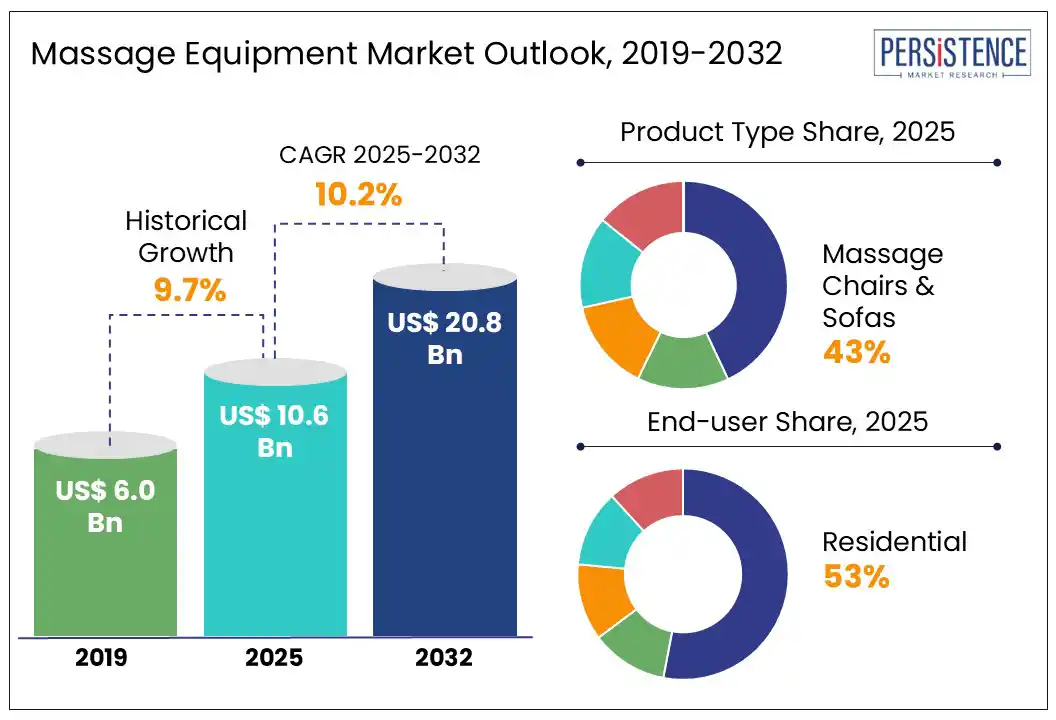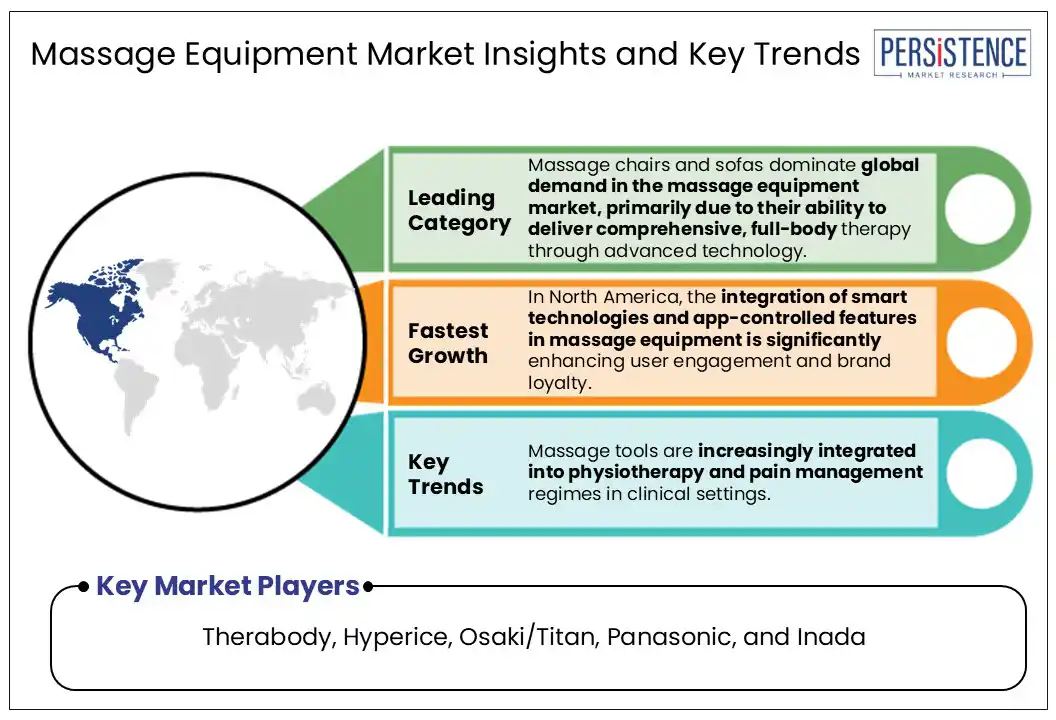ID: PMRREP35483| 194 Pages | 14 Jul 2025 | Format: PDF, Excel, PPT* | Consumer Goods

The global massage equipment market size is likely to be valued at US$ 10.6 Bn in 2025 and is estimated to reach US$ 20.8 Bn in 2032, at a CAGR of 10.2% during the forecast period 2025 - 2032.
The demand for massage equipment has surged across homes, spas, and clinics, driven by the availability of diverse forms such as smart massage chairs, massage robots, sensor-integrated devices, and portable handheld devices. The massage equipment market growth is driven by the rising health and wellness awareness, increasing popularity of at-home self-care routines, technological advancements in massage equipment, rising disposable incomes, and a growing aging population.

Key Industry Highlights:
|
Global Market Attribute |
Key Insights |
|
Massage Equipment Market Size (2025E) |
US$ 10.6 Bn |
|
Market Value Forecast (2032F) |
US$ 20.8 Bn |
|
Projected Growth (CAGR 2025 to 2032) |
10.2% |
|
Historical Market Growth (CAGR 2019 to 2024) |
9.7% |
As modern lifestyles become increasingly hectic, fast-paced, and sedentary, individuals are experiencing higher levels of physical strain and mental fatigue. This shift has led to a stronger focus on personal health and wellness routines within the home environment. Massage equipment such as full-body chairs, handheld massagers, and ergonomic back cushions is now considered an everyday wellness tool rather than a luxury item. The COVID-19 pandemic significantly accelerated this behavioral change, as people avoided public wellness facilities and turned to convenient, home-based alternatives. The ongoing rise of digital wellness platforms, social media influencers, and e-commerce accessibility continues to fuel this trend, making massage devices more mainstream and widely adopted.
Therabody introduced the Theragun Sense, a percussive therapy device designed to alleviate everyday stress and pain. This device combines scientifically proven percussive massage therapy with calming breathwork techniques to promote relaxation and better sleep. RENPHO launched the Eyeris 3, a 2-in-1 eye massager that helps relieve headaches, eye fatigue, and dry eyes, as well as reduce swelling and dark circles. The device combines massage, heat, and spa music for ultimate relaxation, catering to consumers seeking at-home wellness solutions.
While massage devices are increasingly promoted for their potential health and wellness benefits, a significant gap remains in clinical validation and regulatory approval for their therapeutic use. This lack of standardized testing and certification makes it difficult for healthcare providers to assess the safety, efficacy, and long-term impact of these tools. Medical professionals are particularly cautious about recommending equipment that lacks peer-reviewed studies, FDA clearance, or adherence to international health standards.
Inconsistent product quality, exaggerated marketing claims, and the absence of clear usage guidelines across brands further reduce trust. Consequently, hospitals and rehabilitation centers often avoid incorporating these technologies into their formal treatment protocols.
As more individuals seek safer, holistic alternatives to medication and surgical interventions, massage devices are gaining traction for their proven ability to alleviate pain, support recovery, and improve physical function. Equipment such as deep tissue massagers, percussive therapy guns, and pneumatic compression systems is being used to treat muscle stiffness, joint discomfort, and post-operative rehabilitation. This trend is especially visible in physiotherapy clinics, chiropractic practices, and sports rehabilitation centers, where such tools complement traditional therapies. Manufacturers have a valuable opportunity to meet this growing demand by investing in clinical validation, ergonomic design, and compliance with health regulations, ensuring credibility and effectiveness in both clinical and home environments. Sports therapy clinics in Europe incorporate massage and cold therapy in ACL rehabilitation programs, aiding in muscle recovery and reducing inflammation. These methods are integral to both pre- and post-surgical recovery plans.
Massage chairs and sofas are likely to dominate with a market share of approximately 43% over the forecast period, primarily due to their ability to deliver comprehensive, full-body therapy through advanced technology. Massage chairs and sofas combine massage techniques such as kneading, tapping, shiatsu, and rolling into a single device, offering head-to-toe relief. Features, such as heat therapy, zero-gravity positioning, and smart control interfaces, enhance their appeal, making them ideal for home use and premium wellness facilities. Their convenience, comfort, and therapeutic benefits attract a wide user base, especially among aging populations and professionals seeking stress relief. As a result, they lead in both residential and commercial massage equipment segments globally.
The Kyota M688 Kizuna AI Dual Mech massage chair integrates advanced dual-mechanism massage rollers for personalized full-body relief and features innovative cooling technology for a refreshing experience. This chair exemplifies the trend toward multifunctional massage equipment that caters to comprehensive wellness needs. Coway's BEREX Reclining Massage Bed, awarded the Innovation Award in the Digital Health category at CES 2024, features an automatic reclining function and a personalized massage system. This product reflects the growing demand for versatile massage solutions that cater to both relaxation and therapeutic needs.
The residential segment is anticipated to account for a large market share of 53% in 2025, driven by evolving lifestyles and increased health awareness. With the rise of remote and hybrid work models, individuals are spending more time at home, often in sedentary routines that contribute to physical discomfort and stress. As a result, consumers are investing in massage chairs, handheld devices, and back massagers for convenient, on-demand relief. The focus on self-care and mental well-being has also elevated personal wellness to a daily priority. Online accessibility, compact designs, and affordability of devices further support strong demand from households worldwide for at-home massage solutions.
The Titan Pro Vigor 4D Massage Chair features advanced four-dimensional massage rollers that target the vertebrae, shoulders, neck, and glutes with precision. Its intelligent computerized body scan system ensures personalized massage sessions, addressing everyday aches and pains effectively.

North America is projected to dominate, holding a market share of approximately 41% over the forecast period. The integration of smart technologies and app-controlled features in massage equipment is significantly enhancing user engagement and brand loyalty. Consumers increasingly seek personalized, tech-enabled wellness experiences, and massage devices with Bluetooth connectivity, mobile app synchronization, and voice-command functionality to meet this demand. These innovations allow users to customize massage routines, monitor usage data, and access guided relaxation programs through their smartphones. Such features not only improve usability and satisfaction but also position brands as forward-thinking and user-centric. As a result, tech-driven innovation is becoming a key differentiator in the competitive North American market, attracting tech-savvy and wellness-conscious consumers alike.
In July 2024, Aescape introduced fully automated robotic massage stations at locations such as the Kimpton EPIC Hotel in Miami and Equinox gyms. These stations use sensor-driven 3D modeling to offer tailored massage sessions, which users can adjust via intuitive touchscreen interfaces.
In Europe, the growing emphasis on workplace wellness and employee health is driving commercial demand for ergonomic and therapeutic massage equipment. Employers are increasingly integrating massage chairs, back massagers, and neck-relief devices into office wellness programs to reduce physical strain, combat sedentary fatigue, and improve overall productivity. With rising awareness of musculoskeletal disorders and mental health issues related to prolonged desk work, companies are prioritizing preventive care solutions.
Inada, a renowned massage chair manufacturer, collaborated with various European companies to incorporate massage chairs into employee wellness programs. A study conducted by the University of Bergische in Germany evaluated such a program, revealing that 47% of employees experienced reduced drowsiness and tension, while 67% felt more refreshed after using the massage chairs.
Massage equipment tailored for office environments is compact, easy-to-use, and efficient. The products are gaining traction across corporate campuses, co-working spaces, and wellness-centric organizations.
For Asia Pacific, the rapid expansion of the middle-class population, particularly in countries including China, India, Indonesia, and Vietnam, is significantly boosting demand for wellness and self-care products. As disposable incomes rise, consumers are increasingly investing in electric and manual massage tools for personal relaxation, pain relief, and daily rejuvenation. Compact handheld massagers, foot reflexology devices, and massage chairs are becoming household staples, appealing to both younger tech-savvy users and older demographics seeking comfort. The widespread availability of these products through e-commerce platforms and retail chains further accelerates adoption, making massage equipment an accessible and aspirational purchase across income levels.
GINTELL, a leading healthcare retail chain in Southeast Asia, launched the S6 Plus 8-Hands Wellness Chair. This chair features 8-D Twin Rollers that simulate the sensation of four masseuses massaging simultaneously. It also includes an AI Fatigue Bio-Scan system, 230° Thai Stretch, 360° Heat Spa Therapy, and Brain Relief Therapy, catering to consumers seeking advanced wellness solutions.
The global massage equipment market is characterized by intense competition, with numerous players offering a wide range of products catering to residential, commercial, and medical applications. Companies compete on factors such as technology integration, product innovation, design ergonomics, and pricing strategies. The market sees continuous advancements in smart features, portability, and customization to enhance user experience.
Distribution through both online and offline channels is key to maintaining market reach. Players also focus on regional expansion, especially in emerging economies, through partnerships and retail networks. Brand differentiation and consistent product quality are critical for sustaining consumer trust and long-term loyalty in this evolving landscape.
The global massage equipment market is projected to value at 10.6 Bn in 2025.
The massage equipment market is driven by growing consumer awareness of self-care and stress relief.
The massage equipment market is poised to witness a CAGR of 10.2% between 2025 and 2032.
Increasing demand for non-invasive, drug-free pain management and recovery solutions is the key market opportunity.
Major players in the massage equipment market include Therabody, Hyperice, Osaki/Titan, Panasonic, Inada, and others.
|
Report Attribute |
Details |
|
Historical Data/Actuals |
2019 - 2024 |
|
Forecast Period |
2025 - 2032 |
|
Market Analysis Units |
Value: US$ Bn |
|
Geographical Coverage |
|
|
Segmental Coverage |
|
|
Competitive Analysis |
|
|
Report Highlights |
|
|
Customization and Pricing |
Available upon request |
By Product Type
By Technology
By End-user
By Region
Delivery Timelines
For more information on this report and its delivery timelines please get in touch with our sales team.
About Author